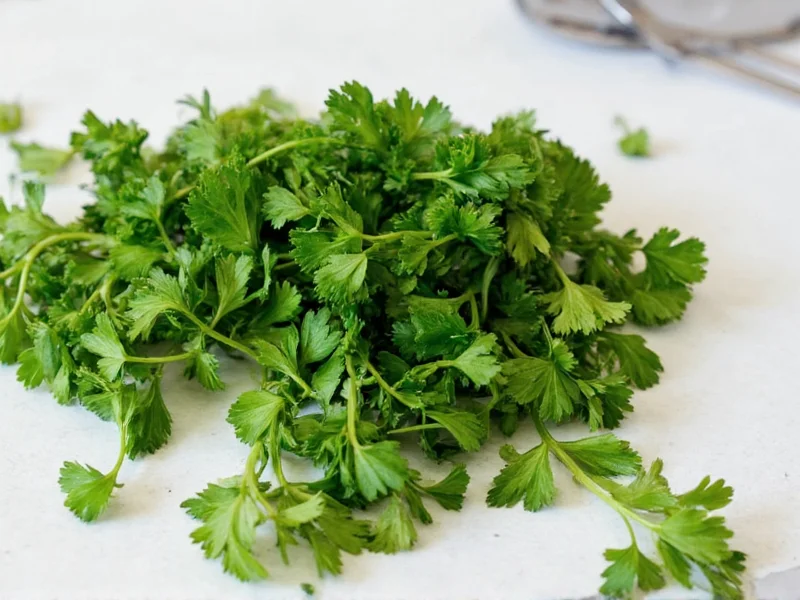Understanding herb conversions is essential for consistent cooking results. When substituting dried parsley for fresh in your recipes, the standard conversion ratio is critical to maintain the intended flavor profile. The 3:1 ratio exists because fresh parsley contains approximately 85% water, while dried parsley has most of this moisture removed, concentrating the flavor compounds.
Why the 3:1 Conversion Ratio Matters
Dried herbs are more potent than their fresh counterparts due to the removal of water content during the drying process. For parsley specifically, this concentration means you need less dried product to achieve similar flavor intensity. The science behind this conversion is straightforward: fresh herbs contain significant water weight that evaporates during drying, leaving behind concentrated essential oils and flavor compounds.
When you're working with a recipe calling for 1/4 cup fresh parsley, using the correct dried equivalent prevents your dish from becoming either bland or overpowering. Many home cooks make the mistake of using equal measurements, resulting in dishes that lack herb flavor or, conversely, become too intense.
Parsley Conversion Reference Guide
| Fresh Parsley | Dried Parsley Equivalent | Common Recipe Application |
|---|---|---|
| 1 cup | 1/3 cup | Large batch soups, stews |
| 1/2 cup | 3 tablespoons | Casseroles, meatloaf |
| 1/4 cup | 1 tablespoon | Sauces, dressings, small portions |
| 2 tablespoons | 2 teaspoons | Garnishes, finishing touches |
| 1 tablespoon | 1 teaspoon | Delicate dishes, precise seasoning |
Practical Substitution Tips for Cooking
When substituting dried parsley for fresh in your recipes, consider these professional cooking tips:
- Add dried herbs earlier: Incorporate dried parsley during cooking rather than at the end, as it needs time to rehydrate and release flavors
- Adjust for recipe type: For acidic dishes (tomato-based sauces, vinaigrettes), you may need slightly more dried parsley as acid can diminish herb flavors
- Consider freshness of dried herbs: Dried parsley loses potency over time; replace your dried herbs every 6-12 months for best results
- Taste as you go: Always adjust seasoning gradually, especially when converting measurements
- Crush dried herbs: Rub dried parsley between your fingers before adding to release essential oils
Flavor Profile Differences to Consider
While the measurement conversion is straightforward, understanding the flavor differences between fresh and dried parsley is equally important. Fresh parsley offers a bright, grassy note with subtle peppery undertones, while dried parsley develops a more earthy, concentrated flavor with less brightness.
Chefs often recommend using fresh parsley for:
- Garnishing finished dishes
- Raw applications like salads and chimichurri
- Dishes where bright herbal notes are essential
Dried parsley works better for:
- Long-cooking dishes like soups and stews
- Recipes where herbs are blended into sauces
- Situations where convenience outweighs peak freshness
Storage Considerations for Optimal Flavor
Proper storage significantly impacts the effectiveness of your herb conversions. Fresh parsley maintains best quality for 5-7 days when stored upright in water (like flowers) in the refrigerator with a plastic bag loosely covering the leaves. Dried parsley retains optimal flavor for 6-12 months when stored in an airtight container away from light and heat.
For the most accurate fresh to dried parsley conversion in your cooking, always assess the condition of your herbs. Wilted fresh parsley may require slightly more volume, while very old dried parsley might need a 25% increase to compensate for flavor loss.
Common Conversion Mistakes to Avoid
Many home cooks make these critical errors when converting between fresh and dried parsley:
- Using equal measurements (1:1 ratio) instead of the proper 3:1 ratio
- Not adjusting for recipe cooking time and method
- Using old dried herbs without compensating for flavor degradation
- Adding dried herbs at the same stage as fresh in the cooking process
- Not tasting and adjusting after conversion
Remember that the 1/4 cup fresh parsley to 1 tablespoon dried conversion serves as your starting point. The final adjustment should always be guided by taste, as individual palates and recipe requirements vary.











 浙公网安备
33010002000092号
浙公网安备
33010002000092号 浙B2-20120091-4
浙B2-20120091-4